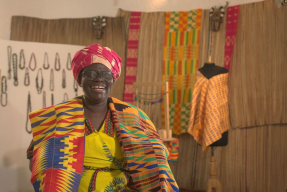There exists a daily beverage that is more omnipresent and culturally dominant than Seattle’s most famous export. It’s a tea known as tereré and (hooray for American marketing) Paraguayans literally do not leave home without it.
Tereré is a loose-leaf tea that is always served cold. It involves no foams, whips, or syrups, and there’s definitely no decaf. Just mate tea, ice water, and, if you like, a mix of mint and lemongrass. As simple as it may sound, bringing these ingredients together is much harder than saying “grande coffee, no room” to the barista. Prepare tereré correctly (sift out the tea dust, crush the herbs to bring out their flavor, tilt the cup at the proper angle when you first pour your water) and you have yourself an incredibly refreshing, slightly stimulating, antidote to Paraguay’s absurd heat. Fail to do these things (or, alternatively, be a Kiva Fellow named Nick Cain) and you’ve got yourself a slightly bitter, mini-stew of floating tea. Like a good cappuccino, to get it right you’ve gotta finesse it.
But once you’ve prepared a good batch, you’re in business for at least a couple hours, and Paraguayans take full advantage of tereré’s staying power. Men, women, teenagers, police officers, grocery store clerks, construction workers, loan officers—everyone carries around a thermos (térmos) full of ice water and a tereré cup (guampa) as they go about their day.

Tea drinking authorities.
Thus, the tea has been ubiquitous in my daily routine as a Kiva Fellow. When I hop on a bus to head to one of Fundación Paraguaya’s branch offices, the driver always has his thermos by his side. Some buses even come equipped with their very own tea caddy: a person whose sole duty is to pass the driver his tereré whenever he requests it. By the time I arrive at the office and shuffle into the kitchen to prepare my morning Nescafe (I know, I know), one or two loan officers are already there crushing herbs and cracking ice cubes. And, of course, as is the Paraguayan custom, when I arrive at the home of a Kiva borrower for an interview I am always directed to take a seat in the shade and have a sip of tea (a custom that led to one particularly memorable moment).

Tea Caddy on Linea 11
When you’re handed a cup of tereré, it’s easy to see that all guampas are not created equal: some are made of wood, some of stainless steel, and others of the more traditional ox horn. But where they really diverge is in their decoration. Many are wrapped in leather, with the owner’s name or business emblem etched into the side. Just as common are those that come adorned with the logo of the owner’s favorite soccer club (also memorable: my soccer allegiance faux pas).
I’d guess that at least 90% of Paraguayans over the age of 14 own a guampa and térmos. Someone has to produce and sell them all, right? Hugo Ruiz, Cipriano Machuca, Graciella Grosella, and Mario Gomez are just some of the many entrepreneurs who have invested Kiva capital in businesses that sell a wide variety of guampas and térmos. Last week I spent some time with Alejandra Alvarez, a mother and an entrepreneur who manages her own business producing, decorating, and distributing guampas and térmos. Since learning the trade more than seven years ago, Alejandra’s business has grown steadily. Her profits helped her build a new, sturdier home on her property, and she currently employs five workers, one of whom is her son Cristian. On the day of my visit, Alejandra’s team was putting the finishing touches on a batch of Mother’s Day guampas so that one of her employees could load them up and deliver them to Ciudad Del Este, a town six hours to the east of Asunción. You can see more of my visit with Alejandra, as well as the guampas, in the video below:
'*******************************************************************************
Nick Cain is in his 11th week as a Kiva Fellow working with Fundación Paraguaya. Based out of Asunción, he travels around the country meeting Kiva borrowers and sharing their stories. Feel free to send questions, comments, or requests for future blog topics to nick.cain@fellows.kiva.org.
/>PREVIOUS ARTICLE
Volley Ball, Skirts and Celebration! →NEXT ARTICLE
Next Kiva Community Conference Call →













